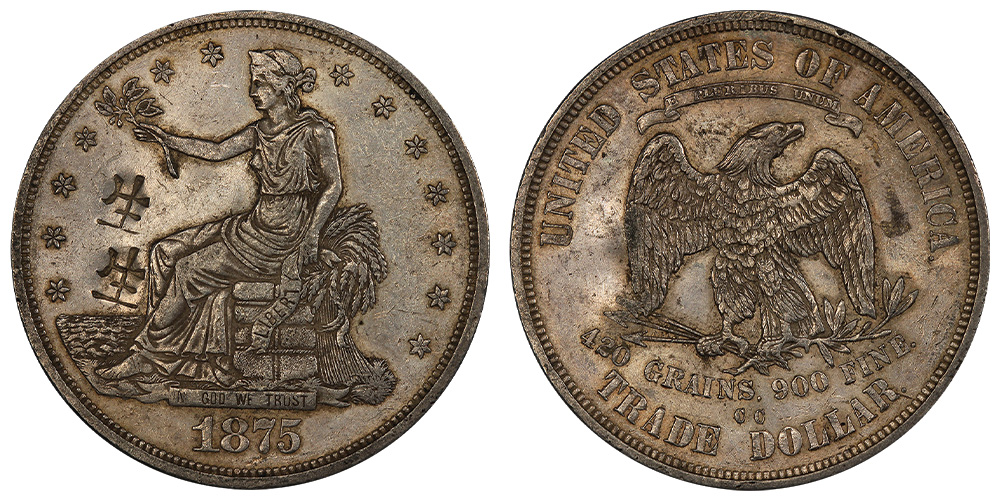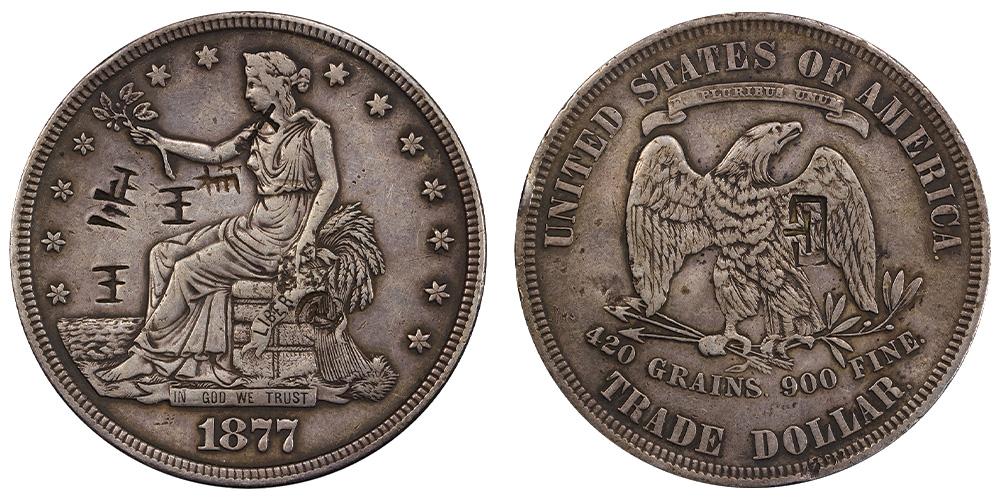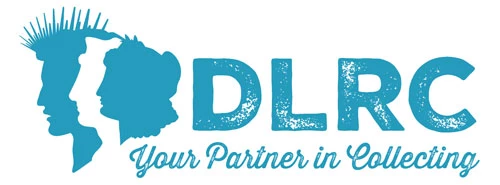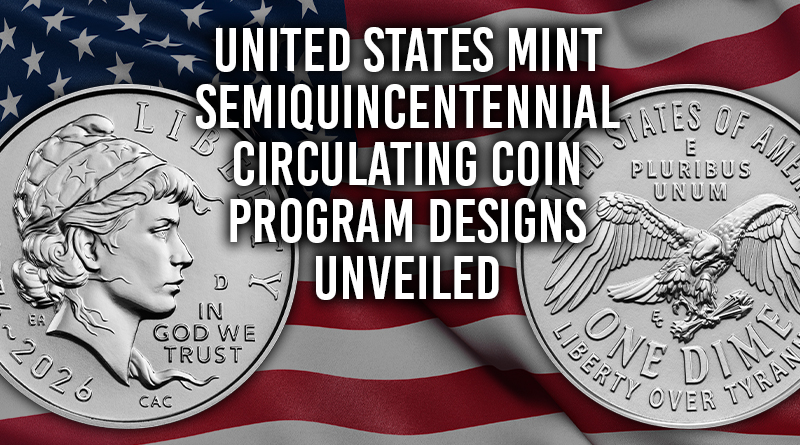An Introduction to Chopmarked Trade Dollars
The bulk of coin collectors have little experience with the Trade Dollar outside of an empty slot in their U.S. Type set, but this short-lived series has a fascinating and unique history spanning both sides of the Pacific.
In the U.S., the Trade Dollar holds the distinction of being the heaviest of the American silver dollars at 27.2 grams (or 420 grains, as noted on the coin's reverse). Thanks to considerable confusion over the type’s legal tender status and its practical value in the United States, the Trade Dollar was also the only coin to be demonetized by an act of Congress, in July 1876; however, they continued to be minted as business strikes designed for export to the Far East until 1878, and in proof format for years after.
In China, the Trade Dollar had a rather different experience, enjoying some commercial success as evidenced by the presence of chop marks on many surviving examples. As part of a practice dating back to the 17th century, Chinese merchants placed chop marks on many types that were commonly used in global trade. These private countermarks, used to verify a coin's silver content and acceptability, were utilized until as recently as the early 20th century. The great majority of Trade Dollars that received these chop marks ended up in Chinese melting pots where they became bullion, typically sycee ingots. The relatively small proportion of chopmarked Trade Dollars that survived U.S. government redemption and destruction for their silver content, spanning a variety of conditions, have become highly collectible and sought after by those who are entranced by the exotic history of these coins.
Typically when describing the Trade Dollar to the non-collector, a romantic retelling of the coin’s history and historical impact can spark the imagination. In the Old West, silver was mined from the Comstock Lode in rough, remote conditions. This silver was carried down from the mines via horse, oxen, or donkey-drawn wagon to the recently-founded mint in Carson City (or shipped to either the similarly new mint in San Francisco, or back to the primary national minting facility in Philadelphia) and coined into Trade Dollars. The Trade Dollars bound for the ports in San Francisco were then placed onto a steam-powered locomotive to be carried through a still very wild Sierra Nevada mountain range. Upon arrival, the coins would be loaded onto a steam ship for the perilous journey to Asia. From that point, the coins would be received by merchants and their corresponding silver specialists (‘shroffs’), chopmarked, and used to purchase silk, tea, spices, and other goods. Some of the chopmarked coins would circulate around the coast and eventually make their way back to the United States over the ensuing century, particularly when it was speculated that the U.S. government would redeem these mutilated coins at their advertised value. Most chopmarked Trade Dollars would end up being melted abroad.
The global trade, heavy usage, and melting of Trade Dollars trimmed a total mintage for the series of 35 million coins to a likely remaining population of 75,000–100,000 coins, per Q. David Bowers; of those surviving coins, probably around 10,000 examples are chopmarked. Total straight-graded examples at PCGS and CACG (services that provide numerical grades to chopmarked examples of the type that show no other condition issues) total fewer than 1,700, which includes approximately 125 CAC stickered examples (NGC does not currently award numeric grades to chopmarked Trade Dollars).

Of the 18 coins in the series (17 date/mintmark combinations and the commonly-included 1875-S/CC overmintmark variety), six issues have fewer than two dozen straight graded examples. On top of the ever-popular and scarce products of the Carson City Mint, Philadelphia issues are prohibitively rare with chop marks, particularly in appealing condition. One factor contributing to the rarity of chopmarked Philadelphia coins (with the exception of the 1877, which is scarce but by far the easiest P mint issue to locate with chop marks) is consistently lower mintages. The other primary cause is simple geography; it was much more difficult for a coin to make its way from Philadelphia to Shanghai compared to a coin starting the trip in San Francisco.
Unsurprisingly, the two key dates for chopped coins are largely the same as their non-chopped counterparts—the 1875 and 1878-CC. The 1878-CC has fewer than a dozen known examples sporting chopmarks. The 1875 is even more difficult, as nearly all purported 1875 specimens feature chop marks conveniently obscuring the mintmark area, or they are actually 1875-S issues with a known, overly-polished die that eventually caused the mint mark to disappear. Fortunately, the 1875 has many distinctive die features and is usually easily identified. Unfortunately, there are exceedingly few undisputed known examples; the true population is unknown, but is likely fewer than five coins. The well-known Legend Collection, despite holding many condition census coins, was never able to add a chopmarked example of the 1875 Trade Dollar to its PCGS Registry set.

Pricing varies for the type with chopmarks. Greysheet recently updated its price guides to reflect recent auction results and private transactions (see online price guide—Ed.), but the market for chopmarked Trade Dollars, while growing, is still relatively small. For common issues, such as high-volume dates from the San Francisco Mint, a 25% discount from a straight graded example is normal. But one of the charming features of the series is the individuality of chopped coins; no two are alike. Some coins can have one or two chops and be otherwise flawless, likely the result of a shroff marking a bag of coins, immediately replacing the coins in the bag, and then disbursing the contents as part of a commercial transaction. These coins can receive grades up to MS64, as chopmarked coins are considered ineligible to receive Gem grades by virtue of their ‘damaged’ status. At the opposite end of the spectrum, examples can have so many chops that a coin can become bowled and barely identifiable. The quantity, placement, and, in some cases, design of the chops can heavily influence the discount (or premium) realized for the coin. Chopmarks can add value to a seldom-encountered date, particularly the aforementioned Philadelphia issues, which are common in un-chopped condition but extremely scarce with genuine chopmarks. The 1874 in AU58 has a CPG of $1,200, whereas a chopped example recently sold at Heritage Auctions for $2,280. The 1873 in VF has a CPG range of $365–$440, while another recent transaction (also via Heritage Auctions) saw a chopmarked 1873 graded VF Details-Cleaned by PCGS sell for $1,800.
For the variety enthusiast, the Trade Dollar has many interesting doubled dies, over mint marks, and repunched dates. The most popular varieties are the 1875-S/CC over mintmark and the 1876-CC Doubled Die Reverse; the 1876-CC DDR features one of the most dramatic and visible doubled dies in American numismatics. However, the 1876-S Doubled Die Obverse is considered the king variety of the series, showcasing extreme and immediately apparent doubling, but with fewer than ten known examples; the finest known example is a chopmarked piece graded PCGS AU55. As a reflection of the depth of the series, PCGS recently began attributing a wealth of varieties, as published in The United States Trade Dollar Challenge 50 Set by John B Coxe.
There are several books addressing chop marks and their history, but Chopmarks by Frank Rose (1987) and Chopmarked Coins–A History by Colin Gullberg (2014) are out of print in English, and can only be found on the secondary market, typically at a large premium. However, a fantastic new book covering the history of chopmarks and the many host coins they can be found on was recently released on Amazon: By Weight, Not by Coyne–An Introduction to Chopmarked Coins, by W. Taylor Leverage.
By Jeremy Maurer

Download the Greysheet app for access to pricing, news, events and your subscriptions.
Subscribe Now.

Subscribe to The Greysheet for the industry's most respected pricing and to read more articles just like this.
Source: CDN Publishing












Please sign in or register to leave a comment.
Your identity will be restricted to first name/last initial, or a user ID you create.
Comment
Comments